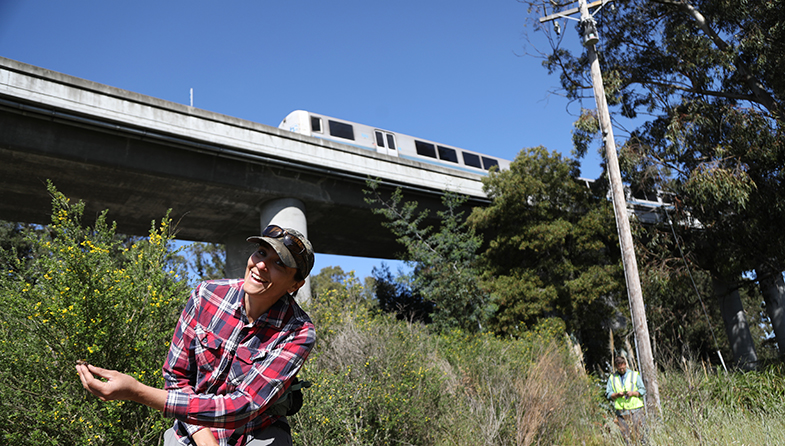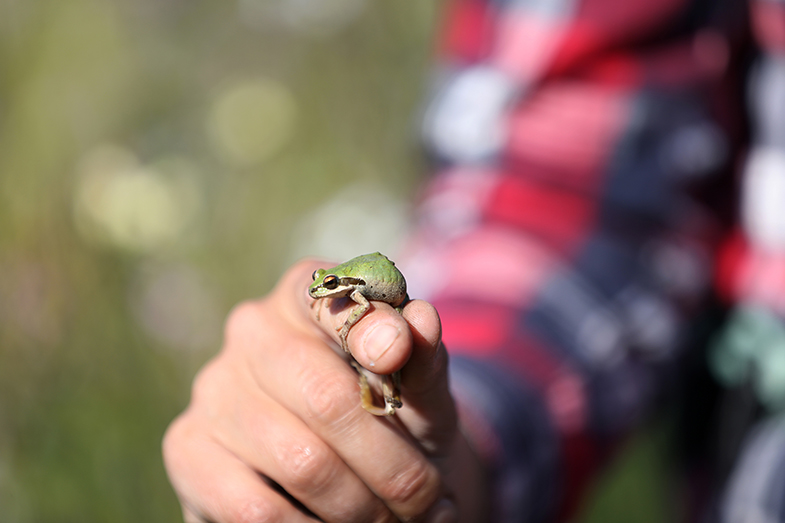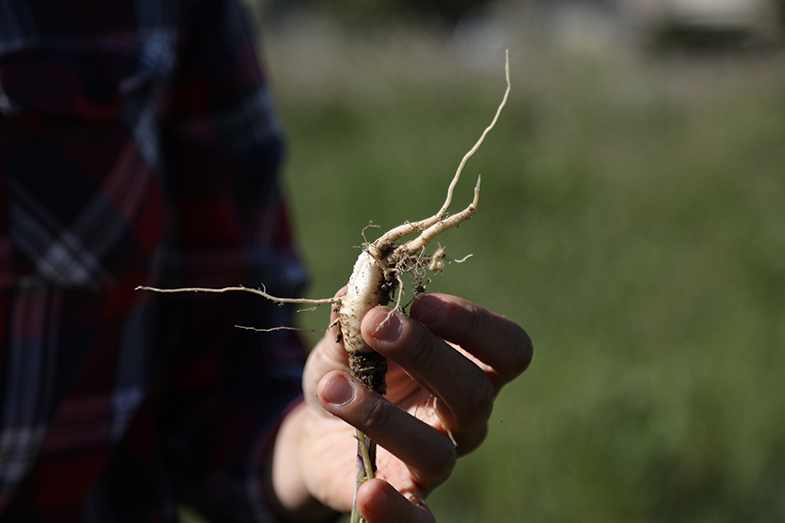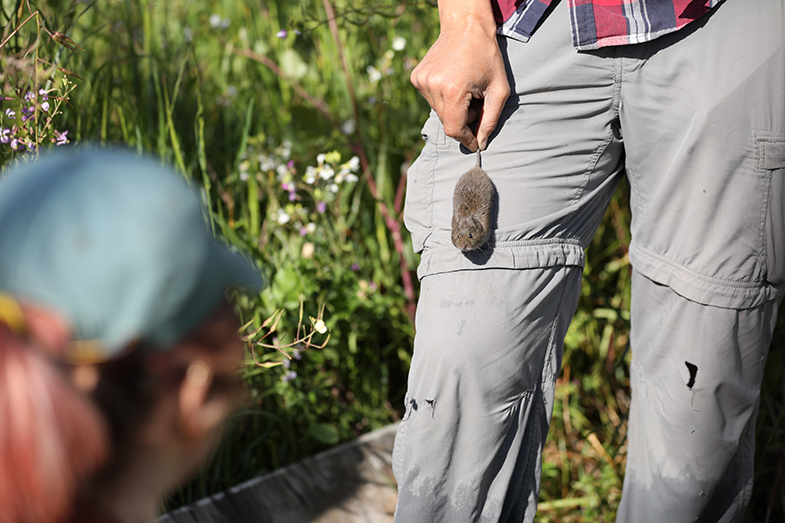Natural beauty by BART: BART, Caltrain, and SFO converge at this nature preserve
SFO biologist Natalie Reeder holds a California red-legged frog as a BART train passes overhead.
In a nondescript residential neighborhood in Millbrae, there is a magical sort of place tucked under freeways and airplane routes, BART lines and Caltrain tracks. Here, the cattails sway with the wind. Lupine explodes in bright shades of purple, yellow, and green. And creatures of all kinds call it home, including the endangered San Francisco garter snake with its shock of blue and red scales.
More than 1,300 San Francisco garter snakes (Thamnophis sirtalis tetrateania) live in this patch of land, the largest population of such magnificent creatures anywhere. The San Francisco International Airport owns and maintains the land, which sits, completely undisturbed, between BART and Caltrain tracks and Highway 101.
Here, the sounds of cars rushing past and airplanes zooming overhead are obscured by gentler, more down-to-earth noises. Red-winged blackbirds (Agelaius phoeniceus) sing their signature “conk-la-ree” song, Sierran treefrogs (Pseudacris sierra) in varying shades of green chirp and ribbit, and even goats (Capra hircus), when the grass requires trimming, bleat into the air, their bellies full of greens.
A Sierran treefrog found in a trap.
SFO’s resident biologist, Natalie Reeder, comes to this fenced-off 180 acres of land to check 87 snake traps two times daily. Reeder is leading a study, which happens every five years, to track the population of the reptiles. One of the rarest snakes in the state, the San Francisco garter snake was listed as a federally endangered species in 1967. It is also listed as state endangered and is fully protected under the California Fish and Game Code. Reeder now serves as a steward of the snakes, which are known for living near bodies of water, such as marshes. A few years ago, SFO developed a “recovery action plan” for the snakes, and surveying the species routinely was a central component of that commitment.
On a recent Friday afternoon, BART staff, along with ERM biologist and BART consultant Michele Barlow, serendipitously encountered Reeder and her team, including Stephen Kraemer and Liz Armistead, checking snake traps in the field.
The root of a wild radish plant.
As the group walked through bushes of purple wild radish – the ancestor of broccoli, cabbage, and Brussels sprouts – and manes of thick, tangled blackberries, Reeder, Kraemer, and Armistead pointed out the site’s diversity of flora and fauna and stressed its important habitat role in an area where such refuges are rapidly depleting.
“I’ve got a frog!” says Armistead as she cradles a baby treefrog in her hands, freshly sprung from a trap. This particular frog is brown in color, but later in the visit, the team finds bright green treefrogs of both the male and female varieties. According to Reeder, the males are distinguishable from the females by a brown, wrinkly throat sac that they use for chirping and attracting a mate.
Moving BART trains flanked by non-native eucalyptus trees.
Without the frogs, there would not be snakes, Reeder explained. “You need saltwater for frogs, and frogs for snakes,” she said.
The San Francisco garter snake prefers one type of frog in particular – the federally threatened California red-legged frog (Rana draytonii), which is, incidentally, also known for its coloring. Found solely in California and northern Baja California, the California red-legged frog is often colored, as you can probably guess, a deep red hue. In 2015, the frog was named California’s “state amphibian.” Like the San Francisco garter snake, the amphibian’s population has declined, likely due to habitat loss spurred in-part by climate change.
“If you’re an animal that needs water, you’re kind of screwed in this day and age,” Barlow said. “There’s a lot of these animals still around, but not as many as there should be.”
The SFO team checked about six traps, wading past wild oats and coyote brush with ladybugs (coccinellidae) alighted atop. The California red-legged frog has remained elusive, as did its predator. The trio did find more treefrogs, including a baby with a heart-shaped spot on its head, and a squirmy brown vole (Microtus californicus), which “love grasses and eating plants,” Armistead said. The team recorded their fauna findings, then released them back into the surrounding grasses to go on with their day.
Reeder holds a vole found in a trap.
If a San Francisco garter snake is found – once, the team recorded 26 in a single day (a very rare occurrence) – the group measures, weighs, pit tags, sexes, and photographs it for their study. They also test some snakes for snake fungal disease, which hasn’t been a problem thus far.
The San Francisco garter snake came to this plot of land likely in the 1940s or 1950s. It’s hard to say how they got there, but Reeder has heard stories going as far back as the 1960s. In all likelihood, some snake enthusiast moved them to this place, where they will now be protected for generations to come.
While BART was building its SFO extension at the start of the century, the San Francisco garter snake twice brought construction to a halt after workers found two dead snakes in the construction area, resulting in one costly delay. Before building started, BART agreed to a slew of precautions intended to protect the snake, including giving workers training in identifying the reptile. By all accounts, the intensive protective efforts worked, and the snakes, though oft elusive to humans, are thriving in this plot of land.
The traps that Reeder and her team use to track the snakes are not inhospitable to the animals. Inside, the snake’s temporary home is barebones. Its only “furniture” consists of some clear “goop,” as the naturalists call it, or “water-storing crystals,” which help keep hydrophilic animals moist. The traps are checked twice a day so that a snake doesn’t find themselves shacked up with a rodent, which are known to nibble on their reptile roommates.
Finally, at the last trap checked on BART’s visit, not one but two California red-legged frogs made their long-awaited appearance. One frog is a muddy brown, with dark spots running down its backs and legs. The other appears more reddish, and it squirms in its handler’s hands, ready to wriggle free. After photographing the frogs and noting them down in a binder, the frogs got their wish and leapt into the safety and obscurity of the tall grass.
A California red-legged frog perched on Reeder’s hand.
Public transit, such as BART and Caltrain, play perhaps an unexpected role in the preservation of these creatures and their habitats. Taking public transit substantially reduces your carbon footprint, and climate change is one of the leading causes of habitat loss and destruction.
“With climate change, there’s less habitat for animals,” Barlow said. “BART helps combat climate change, which can translate into potentially saving an entire species.”
As the sun continued its wide arc in the nearly cloudless sky, the naturalists had more work to do, more traps to survey, and it was time for the BART team to send them on their way.
“COVID has made us comfortable with being alone in cars to protect ourselves from the virus,” Barlow said, reflecting. “But there’s other things worth protecting, too.”
BART recently made a series of transformative changes at SFO Station. You can read more about the improvements – just in time for spring and summer travel – at bart.gov.





